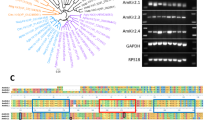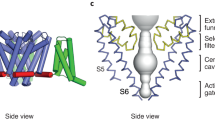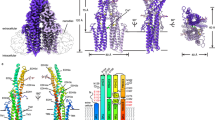Abstract
Potassium channels comprise a diverse class of ion channels important for neuronal excitability and plasticity1,2. The recent cloning of the Shaker locus from Drosophila melanogaster has provided a starting point for molecular studies of potassium channels3–5. Predicted Shaker proteins6,7 appear to be integral membrane proteins and have a sequence similar to the sequence of the S4 segment of the vertebrate sodium channel8, where the S4 segment has been proposed to be the voltage sensor8–11. Expression studies in frog oocytes confirm that Shaker encodes a component of a potassium channel (the A channel) that conducts a fast transient potassium current12. Here we report the isolation of complementary DNA clones from the mouse brain, the nucleotide sequences of which predict a protein remarkably similar to the Shaker protein. The strong conservation of the predicted protein sequence in flies and mammals suggests that these mouse clones encode a potassium channel component and that the conserved amino acids may be essential to some aspect of potassium channel function.
This is a preview of subscription content, access via your institution
Access options
Subscribe to this journal
Receive 51 print issues and online access
$199.00 per year
only $3.90 per issue
Buy this article
- Purchase on Springer Link
- Instant access to full article PDF
Prices may be subject to local taxes which are calculated during checkout
Similar content being viewed by others
References
Hille, B. Ionic Channels of Excitable Membranes (Sinauer, Sunderland, Massachusetts, 1984).
Byrne, J. H. Physiol Rev. 67, 329–439 (1987).
Papazian, D. M., Schwarz, T. L., Tempel, B. L., Jan, Y. N. & Jan, L. Y. Science 237, 749–753 (1987).
Kamb, A., Iverson, L. E. & Tanouye, M. A. Cell 50, 405–413 (1987).
Baumann, A. et al. EMBO J. 6, 3419–3429 (1987).
Tempel, B. L., Papazian, D. M., Schwarz, T. L., Jan, Y. N. & Jan, L. Y. Science 237, 770–775 (1987).
Schwarz, T. L., Tempel, B. L., Papazian, D. M., Jan, Y. N. & Jan, L. Y. Nature 331, 137–142 (1988).
Noda, M. et al. Nature 320, 188–192 (1986).
Greenblatt, R. E., Blatt, Y. & Montal, M. FEBS Lett. 193, 125–134 (1985).
Guy, H. R. & Seetharamulu, P. Proc. natn. Acad. Sci. U.S.A. 83, 508–512 (1986).
Catterall, W. A. A. Rev. Biochem. 55, 953–985 (1986).
Timpe, L. C. et al. Nature 331, 143–145 (1988).
Kozak, M. Cell 44, 283–292 (1986).
Hubbard, S. C. & Ivatt, R. J. A. Rev. Biochem. 50, 555–583 (1983).
Mehraban, F., Breeze, A. L. & Dolly, J. O. FEBS Lett. 174, 116–122 (1984).
Tanabe, T. et al. Nature 328, 313–318 (1987).
Salkoff, L. et al. Science 237, 744–749 (1987).
Hermans-Borgmeyer, I. et al. EMBO J. 5, 1503–1508 (1986).
Bossy, B., Ballivet, M. & Spierre, P. EMBO J. 7, 611–618 (1988).
Perder, F. et al. Cell 20, 555–566 (1980).
Kimura, M. Proc. natn. Acad. Sci. U.S.A. 78, 454–458 (1981).
Kemp, B. E. et al. J. biol. Chem. 252, 4888–4894 (1977).
Goeddel, D. V. et al. Nature 290, 20–26 (1981).
Grenninglon, G. et al. Nature 328, 215–220 (1987).
Nathans, J., Thomas, D. & Logness, D. S. Science 232, 193–202 (1986).
Lonberg, N., Gettner, S. N., Lacy, E. & Littman, D. R. Molec. cell Biol (in the press).
Sanger, F. et al. Proc. natn. Acad. Sci. U.S.A. 74, 5463–5467 (1977).
Sobel, E. & Martinez, H. M. Nucleic Acids Res. 14, 363–374 (1985).
Cleveland, D. W. et al. Cell 20, 95–105 (1980).
Author information
Authors and Affiliations
Rights and permissions
About this article
Cite this article
Tempel, B., Jan, Y. & Jan, L. Cloning of a probable potassium channel gene from mouse brain. Nature 332, 837–839 (1988). https://doi.org/10.1038/332837a0
Received:
Accepted:
Issue Date:
DOI: https://doi.org/10.1038/332837a0
Comments
By submitting a comment you agree to abide by our Terms and Community Guidelines. If you find something abusive or that does not comply with our terms or guidelines please flag it as inappropriate.



